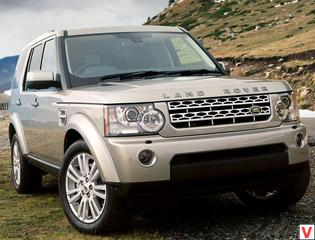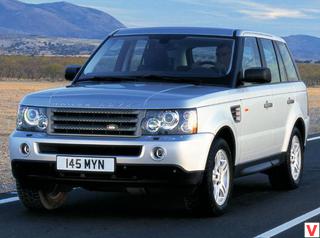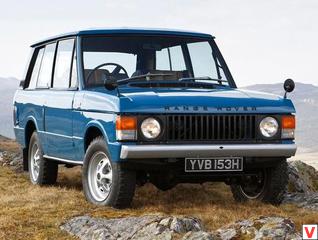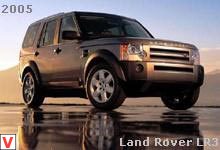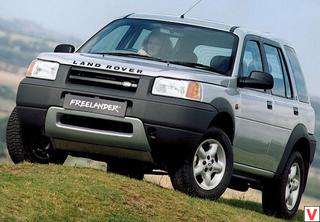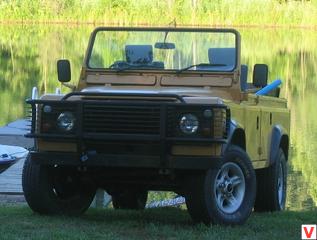
In 1989, the premiere of the new Land Rover-Discovery model took place. It was designed to take place between the utilitarian Defender and the luxury Range Rover. At first, the three-door version was introduced, and only a year later the five-door appeared. It should be noted that the wheelbase of both options is the same and is 2540 mm. The body is fixed on a strong almost "eternal" frame.
Spring suspension of the front and rear wheels is made according to the traditional pattern for off-road cars. These are continuous beams of bridges fixed on the levers. Discovery used disc brakes on all wheels, which was quite rare for SUVs of the late 80s.

The effectiveness of the braking system is excellent and gives the car a small stopping distance even when towing a heavy trailer. At first Discovery was completed with a gasoline 3.5-liter V8 engine. On instances of the first year of production in his power system used two carburetors. In a modification with an EFI injector, this 3.5-liter unit was offered until 1993. And at the end of 1989, a 3.9-liter engine producing 182 hp was created at its base.
This power unit gives the car excellent dynamics for an SUV and allows you to dial a "hundred" in 11 seconds. He has a solid resource, but it is not without drawbacks. For example, high fuel consumption during active driving in urban environments is 20-25 liters per 100 km. In the range of gasoline engines was one high-speed 2.0-liter 136-horsepower unit. It has been installed since 1993.

If there are MPI (Multi-point injection) letters on the tailgate of the car, it means that this two-liter engine is used on it. Also for the model offered turbo diesel. In 1990, Discovery got a 2.5-liter engine producing 107 hp. with turbocharger and intercooler. In general, it is a reliable and economical unit (with active driving the maximum diesel fuel consumption is 13-14 liters). For Discovery offered automatic and manual transmission. First, a manual gearbox with a LT77 factory index was used on the car.
In 1994, it was replaced by a new “mechanic” (index R380), which also has synchronized reverse gear. One of the main advantages of Discovery is the permanent full drive (full-time 4WD). To distribute the moment on the "axes" when driving off-road in the transfer case used lockable center differential. In 1991, a small modernization was carried out, as a result of which rubber moldings were added, a drawer between the seats and fixing nets in the trunk. In addition, a new five-speed gearbox began to be installed.

In 1994, the model was restyled. External differences were insignificant, but a new dashboard appeared in the interior, and a new “mechanic” appeared in the transmission. In the same year, off-road vehicle sales began in the United States. Discovery was produced in several trim levels.
The baseline before the restyling of 1994 included electric equipment (except for the three-door versions), and the most expensive was presented with an almost complete list of all sorts of “bells and whistles” worthy of a high-end passenger car. After restyling, the air conditioner entered the list of standard equipment. Then debuted a luxury modification with an index of ES. It had a leather interior, electric chairs and hatches (there could be two), an expensive audio system with a CD player, in general, everything that you could wish for. In 1996, all versions for North America began to complete the 4.0 liter gasoline engine, previously installed on the Range Rover.

Discovery has won great popularity among people leading an active lifestyle. Considerable share in the popularization of Discovery made competition Camel Trophy, where the car gained a reputation as the best conqueror of off-road. For the competition, Camel Trophy produced a special version of the car, called the Land Rover Discovery for the Camel Trophy Special. It differed, in addition to the bright yellow color of the body, by the presence of special off-road devices and accessories: for example, a remote air intake, a powerful trunk, a winch, additional lighting (“chandelier”) and many others. In general, Discovery has many positive qualities.
This is a good handling, ergonomics, comfort, high security. In 1998, a new model, the Discovery II, was introduced. The car looks very similar to its predecessor. Not just the style has been saved, but all the most characteristic features and design features. But at the same time the car is fully developed anew.

It is easiest to distinguish a novice from a veteran due to the extended rear overhang, the new front end, as well as the high-mounted rear lights. Discovery II is noticeably larger and more capacious. The wheelbase has remained the same, but the length has increased by as much as 18 cm. Thanks to this, it was possible to place two third-row directional seats in the cabin instead of “otkidushek”. But the main differences, of course, in the technical part. The foundations of the Discovery II off-road ideology remained unchanged - the frame structure and dependent suspensions with rigid bridges in front and behind.
However, a completely different system has become all-wheel drive. As before, it uses permanent all-wheel drive, but now the center differential has become free, and the need to block it is replaced by the ETS electronic traction control system, which brakes slipping wheels. The four-channel ABS with electronic brake-force distribution and Hill Descent Control (HDS) system, which limits the speed of movement on steep descents, has become the standard for all Discovery versions.

The two most expensive modifications of the Discovery II received a pneumatic rear suspension that automatically maintains the level of the body above the road, regardless of the degree of loading of the car and allowing it to be slightly raised in difficult situations on the roads. By the way, both the front and rear axles are suspended on two trailing arms. The Watt mechanism is used to perceive transverse forces from behind, while the more familiar Panhard thrust is set to the front. The air suspension version also includes the Active Cornering Enhancement (ACE) system, which modifies the stiffness of the anti-roll bars.
The sophisticated electronic-hydraulic system is designed to resolve the contradiction between the need to provide large suspension travel when driving off-road and the desire to reduce roll in corners in normal conditions. The power units also underwent changes - the petrol V8 was modernized, and instead of the old diesel engines, a completely new five-cylinder turbo diesel of 2.5 liters was used. Interior design is no less conservative than the exterior of the car. Controls at their usual places. Those sitting behind can hardly complain about the tightness - and in width, and for the legs there is enough space.

The reserve of space above the head is huge at all, because the roof above the rear part of the cabin, as, indeed, on the first-generation Discovery, is noticeably elevated. There are even small mesh pockets for details in its trim. The trunk is huge. In addition, in the absence of third-row folding seats, there are large lockable drawers in the sidewalls of the luggage compartment. There is a shelf on the tailgate, there is a set of tools.
In 2004, the presentation of the third generation Discovery. And in the US, the model began to sell under the new name LR3. Despite several hundreds of design differences, the exterior of the car is quite recognizable. Discovery III was created based on the Ranger Rover platform with a strong frame integrated into the body power frame (Body-Frame technology), which made it possible to increase body rigidity in torsion and significantly improve handling parameters. Pneumatic independent suspension not only improved the smoothness of the course, but is also one of the component parts of the new proprietary all-wheel drive system, called the Terrain Response.

This electronic system optimizes traction and speed characteristics, the level of stiffness of the suspension and ground clearance, depending on the road surface or characteristics of rough terrain. Gamma engines for 2005 for Europe - petrol 4.4 liter V8 with a capacity of 300 hp and a 2.7 l turbodiesel with variable turbine power of 190 hp And for the United States and Canada, a 4.0 liter V8 engine with a capacity of 213 hp is proposed. from Explorer. For gasoline versions, only a 6-speed “automatic” is offered, and for a turbo diesel engine, a 6-speed “mechanics” is considered to be the base.
In Russia, there are three configurations - S, SE and HSE. The equipment list includes ABS, Stability Control System DCS and ARM anti-tipping system, front, side and window airbags, and a luxurious audio system. In addition, the car is literally lashed with such well-known electronic devices as ETC, EBD and, of course, HDS. The fourth generation of Discovery debuted in April 2009 at the New York Auto Show. External changes are minimal - the lines are a little stricter, the front bumper is made more streamlined. The aggressive and dynamic style is underlined by new alloy wheels, side diffusers and LED optics both in front and behind.

A new look was also given to the brand elevation of the rear part of the roof, which has now become completely glass. The designers did not change only the original rear asymmetric double door - a bright distinctive feature of the latest Discovery. In addition, a wide range of body colors was added to Discovery 4 with three new spectacular options: Baltic Blue, Fuji White and Siberian Silver.
For particularly sophisticated customers, Land Rover has even released a limited edition Landmark in an exclusive exterior and interior trim. Changes in the interior much more. The masters from the Conran Design Studio worked on the interior decoration.
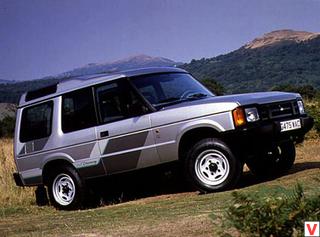
Chairs, dashboard, center console, finishing materials - everything is new. Each element is worked out in detail, and this is manifested in literally everything. Designers paid special attention to ergonomics, quality of finishing materials, sound insulation and details. The central console has lost uncomfortable corners and a large number of buttons, instead of which a color monitor with a touch control takes center stage. The display is multifunctional, it displays the functions of the HarmanKardon media system with the ability to connect an iPod or USB, onboard computer readings, images from five digital cameras of circular video surveillance, navigation maps and much more.
Landing driver high. There is more than enough space both in length and height, and even more so in width. The steering column is electrically adjustable, and if you stop the engine, it automatically moves up and forward, making it easier to land and land. For those who like to relax behind the wheel and the front passenger has individual folding armrests. On the second row, too, expanse, a step in the roof allows you to arrange the seat "amphitheater." At the service of second-row passengers: coasters, climate system, heated seats with two intensity modes and the ability to connect electronic devices.
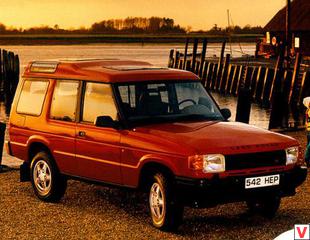
An optional entertainment system for rear seat passengers allows riders to independently watch DVD and TV movies (headphone outputs are provided) or play portable set-top boxes. The huge Land Rover Discovery IV saloon is easily transformed, the extra seats in the trunk fold into the floor, and the back of the second row is assembled in proportion to 35/30/35. As a result of such operations, a flat loading platform is formed from the back door to the driver’s seat. The amount of luggage varies from 1260 to 2558 liters.
Capacities for trifles in the cabin abound. And almost all of them are quite roomy. In addition to an impressive list of basic equipment (keyless access, full power, rain and light sensors, cruise control), many additional options are offered: a steering wheel and a heated windscreen, a cooled box in the armrest, a tire pressure sensor, an autonomous heater with remote control, etc. .
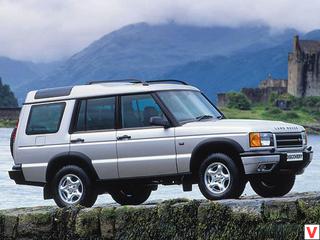
The main innovation in the Discovery IV was the new engines, which are able to provide excellent dynamics to a large SUV, whose curb weight is 2.6 tons. Diesel V6 2.7 did not change, just added a three-liter biturbodiesel created on its basis to the range of engines. In addition to a small increase in working volume, the motor received a clever system of parallel-serial biturbon supercharging.
At low revs only one large turbine operates, then another smaller one is connected. Such tricks allowed to reduce fuel consumption by 10% compared with the 2.7 engine, while increasing power by 55 hp and torque by 160 Nm. Total 245 hp and as much as 600 Nm. Acceleration to 100 km / h takes 9.6 seconds.
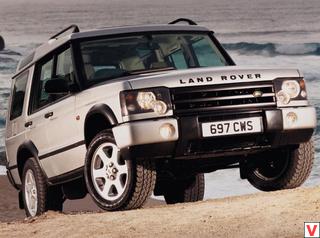
The place of the former petrol V8 4.4 l took a five-liter engine with direct fuel injection, able to change the valve timing, valve lift height and the length of the intake tract. The power of this unit is 375 hp, the moment is 510 Nm. With him, the car accelerates to a hundred in 7.9 seconds. The engines are offered a 6-speed automatic transmission from the ZF, steering with improved feedback and new disc brakes with floating calipers.
In the technical stuffing changes, compared with Discovery 3, too much. Chassis redesigned to improve the asphalt manners of an SUV. Anti-roll bars became thicker, and the steering rack now with variable pitch. The off-road system Terrain Response has changed the control program of some modes. Now in the “stones” mode, the pads are automatically brought closer to the discs, so the response time of the brakes is reduced.
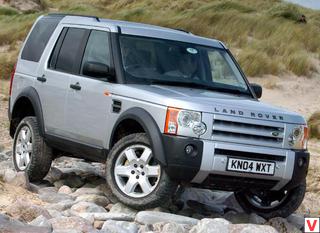
Rewrote the algorithm of the program "sand" and the blocking mode of the central differential. Air suspension is now included in the basic package. The brake system has become more efficient due to larger diameter discs and floating calipers - two-piston front and single-piston rear.
Other images auto Land Rover Discovery
